NCHS: A Blog of the National Center for Health Statistics
New Reports on ADHD and Opioid Use Disorder in Health Center Visits

The National Center for Health Statistics (NCHS) has released two new reports on health center visits for adults in the United States with attention-deficit/hyperactivity disorder (ADHD) and opioid use disorder (OUD). These reports are based on data from the 2023 National Ambulatory Medical Care Survey Health Center Component. Health centers are local, community-based clinics that Read More >
Posted on byExplore the New NCHS Dashboard for Death Data in Puerto Rico
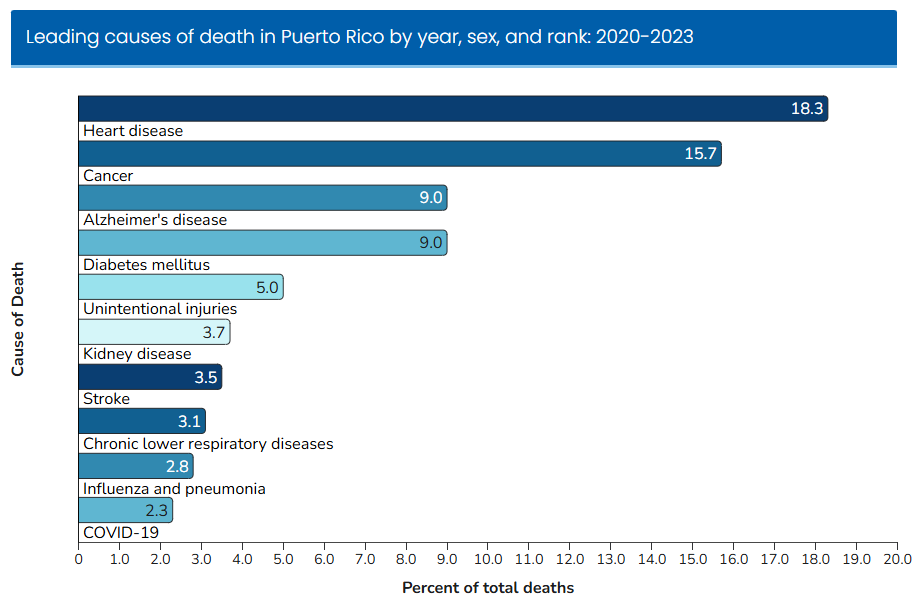
NCHS has launched a new data visualization dashboard that provides insights into the leading causes of death (mortality) in Puerto Rico from 2020 to 2023. This launch coincides with the addition of new mortality data for Puerto Rico to the CDC WONDER platform, enhancing our understanding of public health in the commonwealth. Key Findings from Read More >
Posted on byLife Expectancy Increased in Most States in 2022
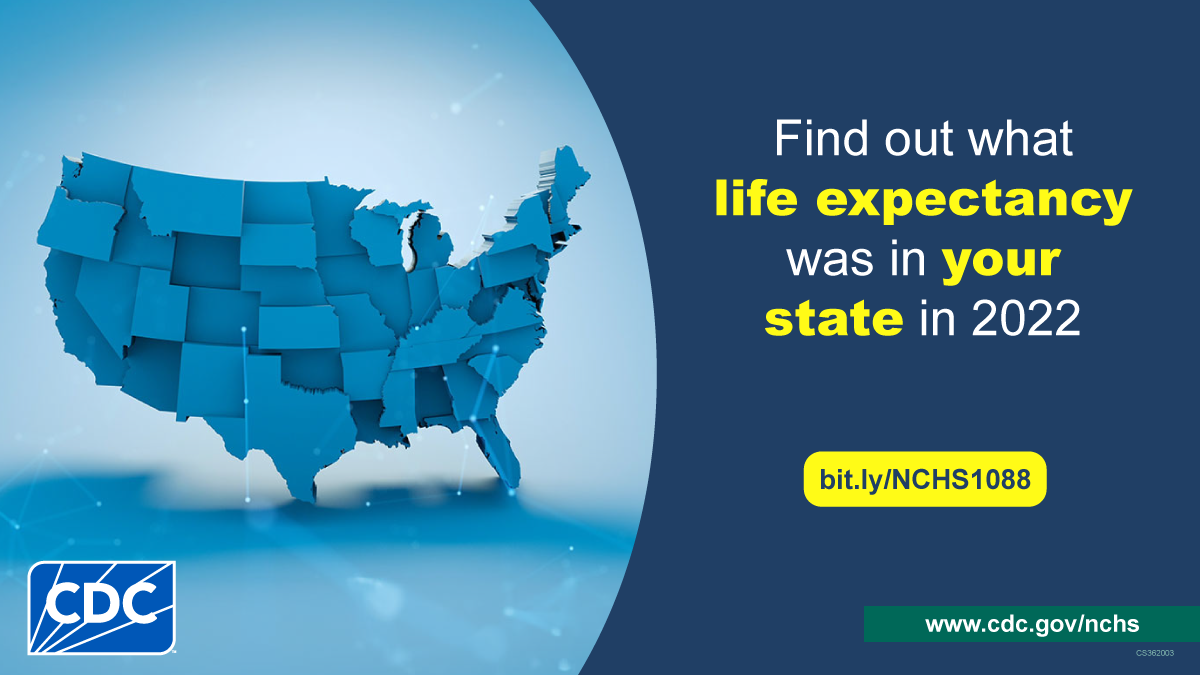
The National Center for Health Statistics recently released its report titled “U.S. State Life Tables, 2022,” providing life expectancy data across all 50 states and the District of Columbia. A data visualization map is also available, allowing for an easy exploration of these findings. Top States for Life Expectancy at Birth in 2022 Hawaii: 80.0 Read More >
Posted on byComparing Parent and Teen Reports on Healthcare Use

Routine healthcare visits play a crucial role in the lives of adolescents aged 12 to 17. These visits not only help identify health issues but also support teens as they transition into adult healthcare systems. Regular checkups can help teens develop good health habits that they can keep as they grow up, making it important Read More >
Posted on bySuicide Rates Largely Unchanged in 2023, but Still High
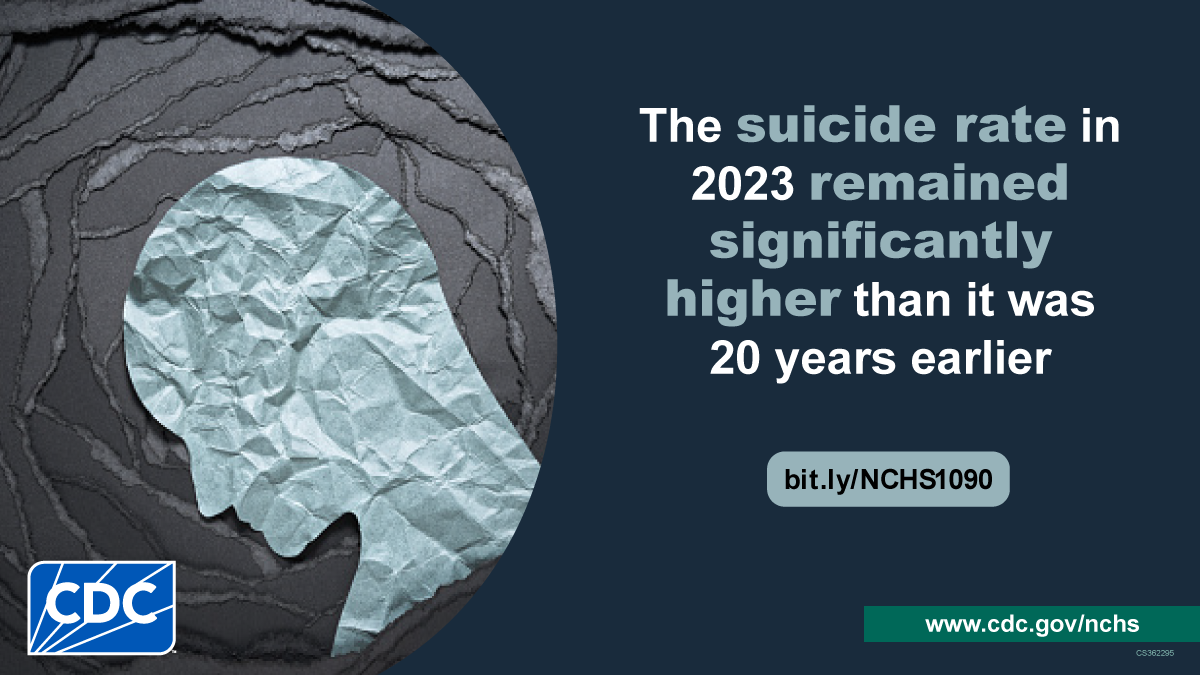
A new NCHS report, “Changes in Suicide Rates in the United States From 2022 to 2023,” sheds light on the trends surrounding suicide rates over the past two decades. This report tracks the statistics from 2003 to 2023 and focuses on notable changes in 2022 and 2023. Recent Stability in Overall Rates From 2003 to Read More >
Posted on byNCHS Provisional Report on U.S. Mortality for 2024
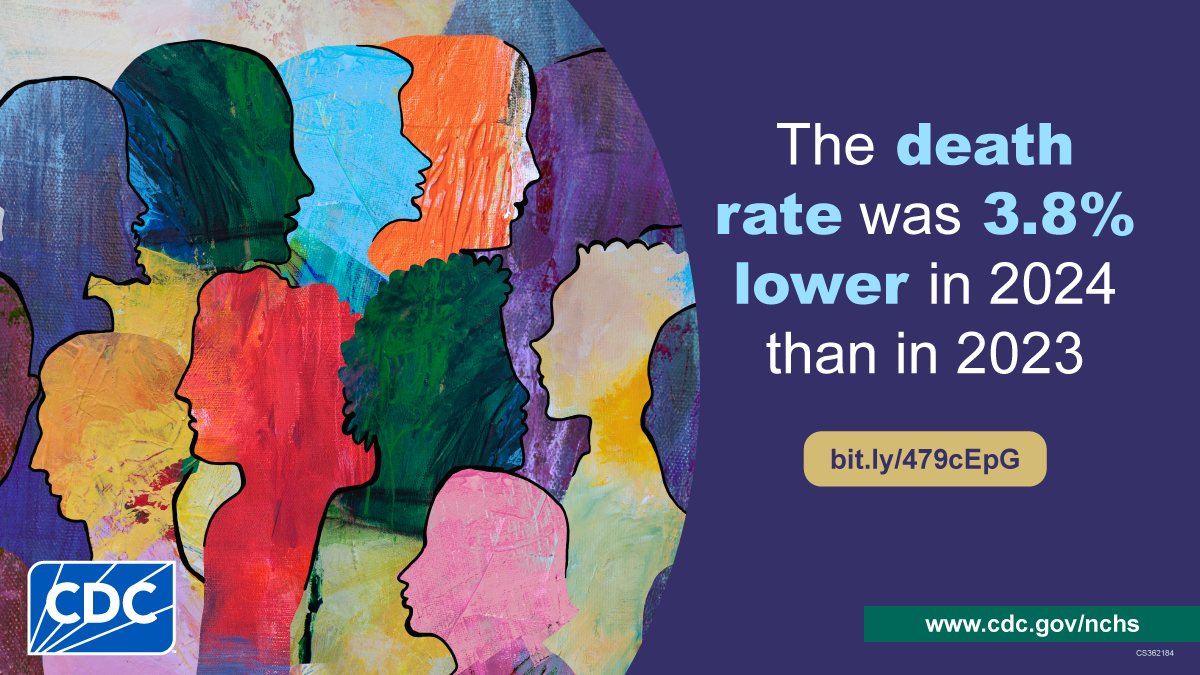
NCHS has just released a new report titled “Mortality in the United States: Provisional Data, 2024.” This report offers an early snapshot of death rates across the country, breaking down the data by age, sex, race, and Hispanic origin. It also highlights the leading causes of death in the United States. According to the report, Read More >
Posted on byMen and Women’s Use of Birth Control
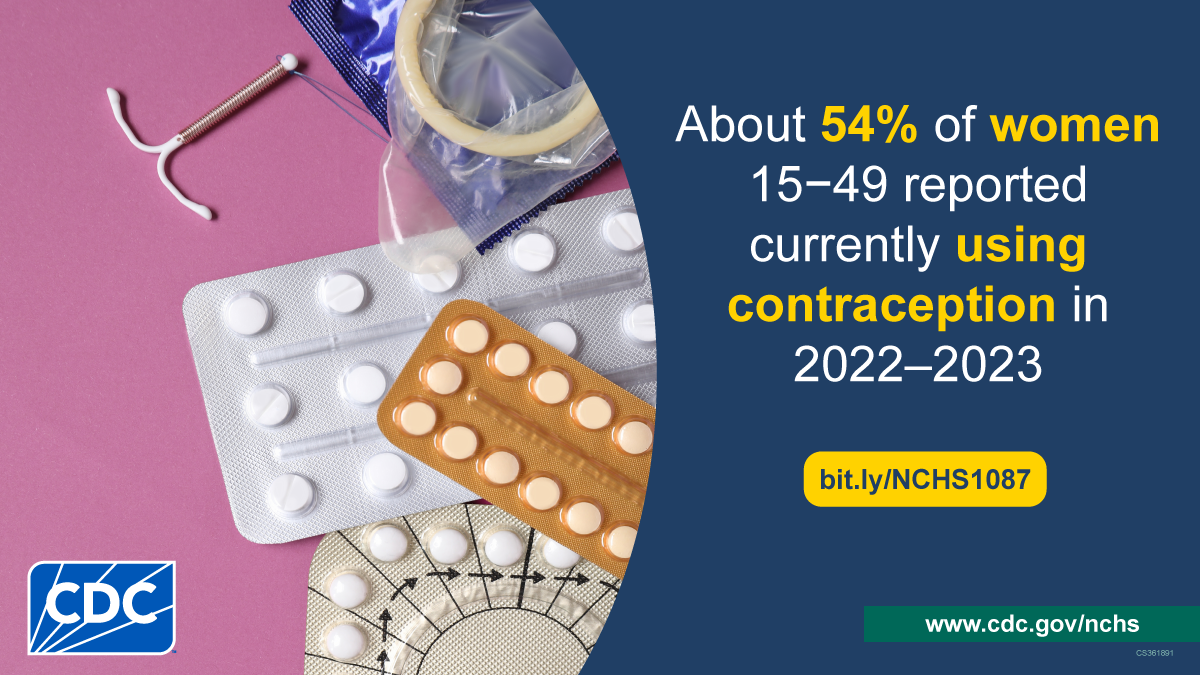
Understanding how men and women use birth control (contraception) gives us important information about trends in fertility, like birth rates and unintended pregnancies. Two new reports from the National Center for Health Statistics highlight patterns in the contraceptive methods men and women are using. Vasectomy Use Among Men The first report looks at men who Read More >
Posted on byHow Much Ultra-Processed Food Are People Eating in the United States?

A new NCHS report shows how much ultra-processed food people in the United States have been eating. Ultra-processed foods can be very tasty and convenient, but high in calories and often lack important nutrients and fiber. They often contain little to no whole foods and are characterized using ingredients typically not found in home kitchens. Read More >
Posted on byFinal U.S. Birth Data Show a 1% Fertility Rate Decrease
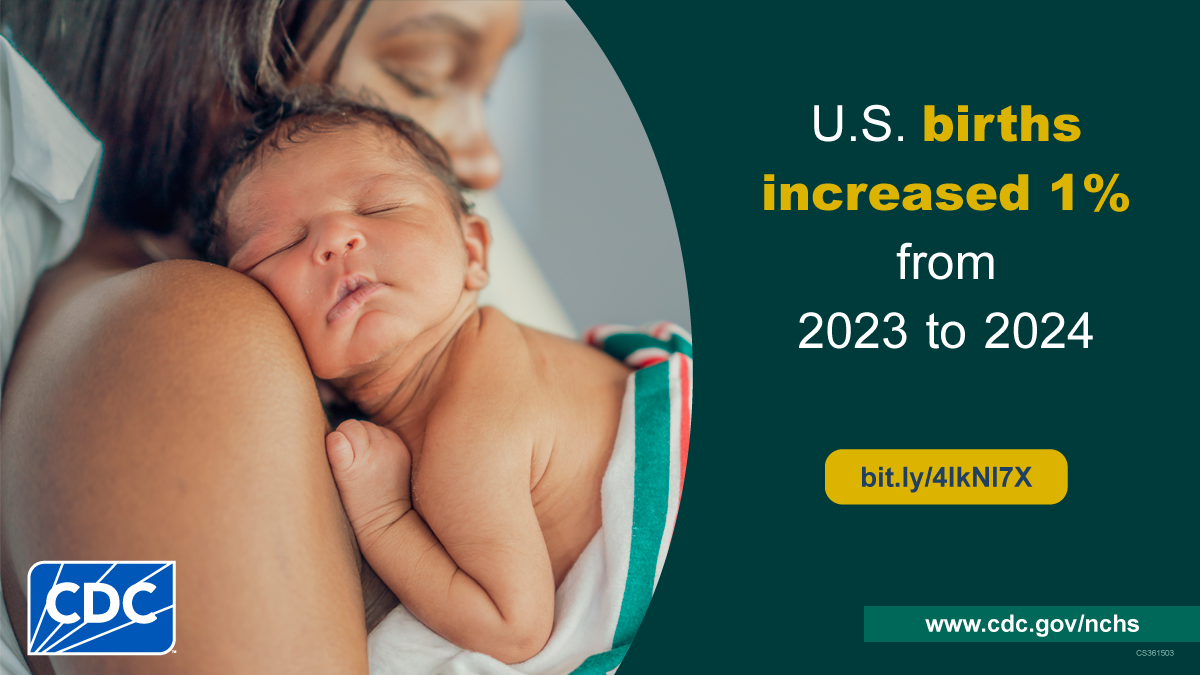
Early calculations in April used different Census population data The National Center for Health Statistics (NCHS) has released a new report, Births in the United States, 2024 that gives the final numbers for births last year. This report follows an April report that shared provisional data. In the April report, the provisional general fertility rate—the Read More >
Posted on byNCHS Data Query System Launches New Features
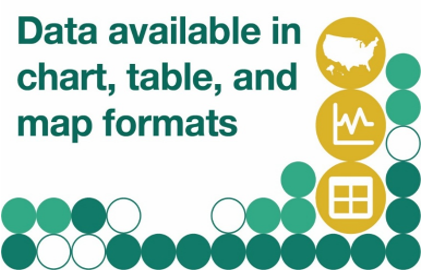
The National Center for Health Statistics (NCHS) released new features and enhancements to its Data Query System (DQS). DQS, originally launched in spring of 2024, is an online query and visualization tool that compiles statistics from more than 150 health topics into one easily searchable resource. DQS helps you access thousands of health estimates from Read More >
Posted on byHow Much Fast Food Do We Eat in America?

Eating fast food is often the focus of public health conversations, particularly the role fast food may play in healthy eating habits and health outcomes. Two new reports from the National Health and Nutrition Examination Survey (NHANES) provide insight about how much fast-food U.S. adults and youth are eating. These reports rely on data from Read More >
Posted on byThe Rising Age of Motherhood in the United States
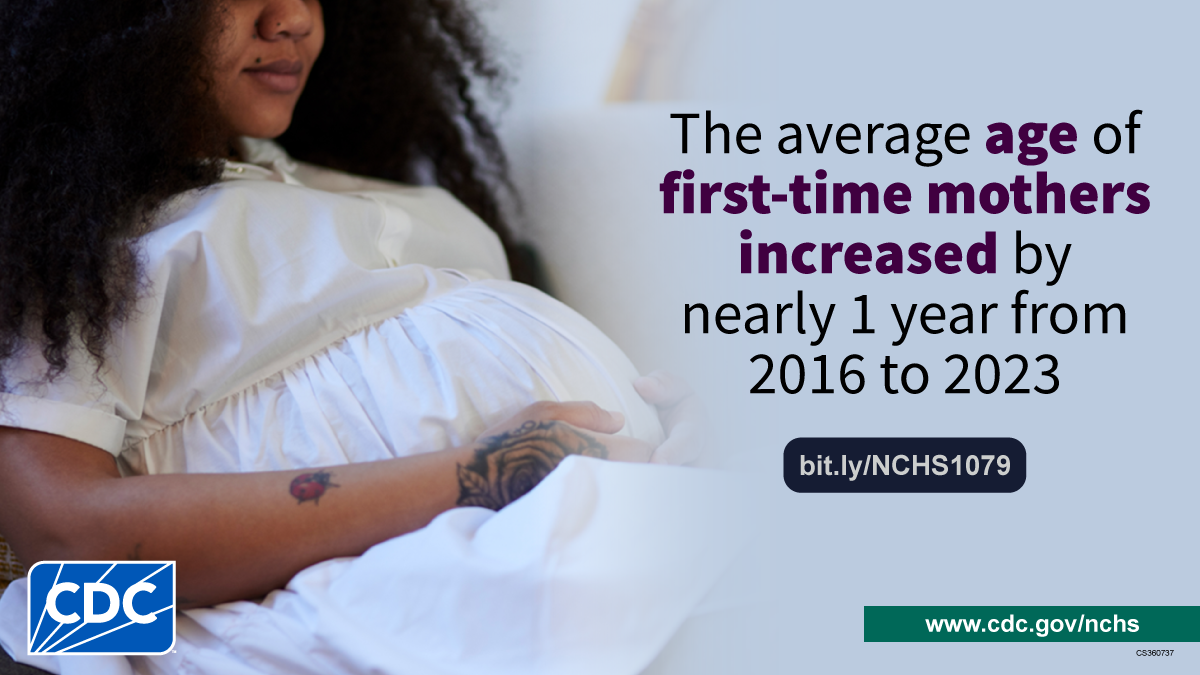
Women in the United States are having children later in life. A new report, “Trends in Mean Age of Mothers in the United States, 2016 to 2023,” reveals that the average age of first-time mothers has increased from 26.6 years in 2016 to 27.5 years in 2023. This trend isn’t limited to first-time moms; the average age Read More >
Posted on byNew Methods Help Fill Health Data Gaps while Protecting Privacy

Innovative Statistical Strategies Provide “Synthetic” Data Developed from Survey Participant Responses NCHS researchers compare methods for developing synthetic data for complex surveys, highlighting one that strikes the ideal balance between data usefulness and privacy protection. When you fill out a health survey or provide personal information at a medical visit, you probably trust that your Read More >
Posted on byQuickStats: Mental Health Treatment Trends Among Adults Aged ≥18 Years, by Age Group — United States, 2019–2023
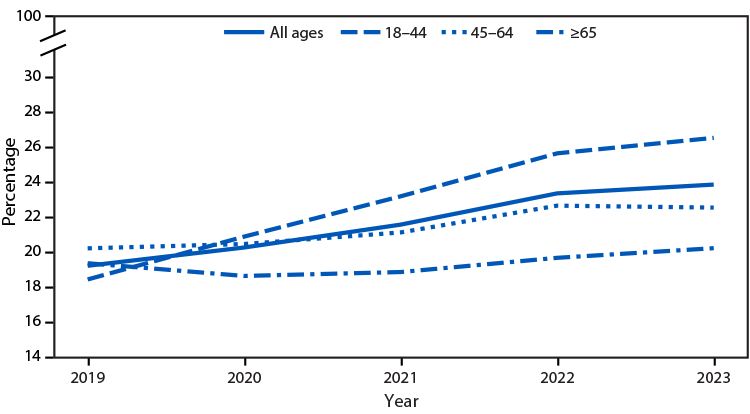
From 2019 to 2023, the percentage of adults who had received any mental health treatment during the past 12 months increased from 19.2% to 23.9%. This pattern was similar among adults aged 18–44 and 45–64 years. No significant change was observed among adults aged ≥65 years. Supplementary Table: https://stacks.cdc.gov/view/cdc/174552 Source: National Center for Health Statistics, National Health Read More >
Posted on byNew Reports Confirm U.S. Life Expectancy Increased while Drug Overdose Deaths Decreased in 2023
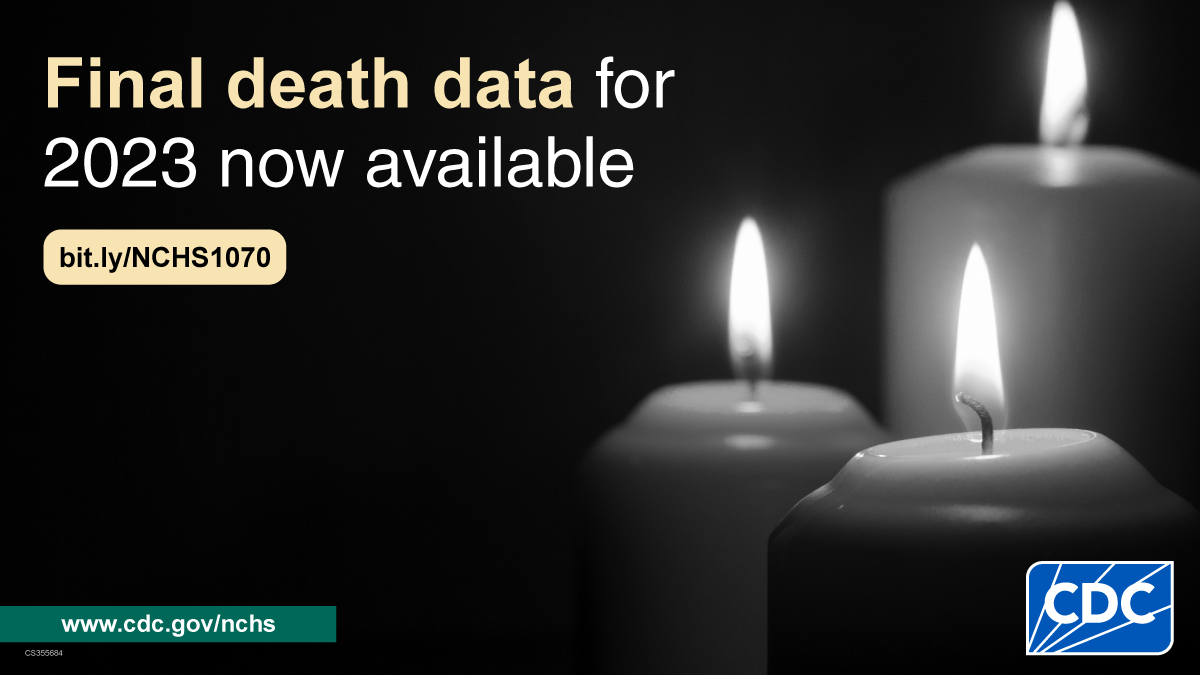
U.S. life expectancy increased in 2023, reaching its highest level since the COVID-19 pandemic, according to final mortality data released today. The data are featured in two new reports from CDC’s National Center for Health Statistics (NCHS). “Mortality in the United States: 2023” is the first public release of final mortality data for 2023. The Read More >
Posted on byQuickStats: Age-Adjusted Percentage of Adults Aged ≥18 Years with Diagnosed Chronic Obstructive Pulmonary Disease, by Urbanization Level — United States, 2023
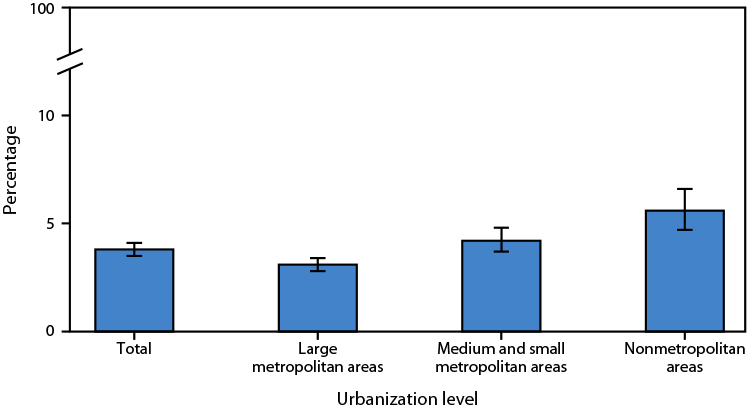
In 2023, the age-adjusted percentage of adults aged ≥18 years with diagnosed chronic obstructive pulmonary disease (COPD) was 3.8%. The prevalence of COPD among adults increased as urbanization level decreased. Supplementary Table: https://stacks.cdc.gov/view/cdc/168877 Source: National Center for Health Statistics, National Health Interview Survey, 2023. https://www.cdc.gov/nchs/nhis.htm https://www.cdc.gov/mmwr/volumes/73/wr/mm7346a5.htm Read More >
Posted on byNCHS Recognizes National Rural Health Day

Each year, we celebrate National Rural Health Day on the third Thursday of November. One in five people in the United States live in rural areas. Many of these residents face unique challenges that can affect health, such as higher poverty rates and less access to care. National Rural Health Day reminds us of the Read More >
Posted on byQuickStats: Percentage of Adults Aged ≥18 Years Who Were in Families Having Problems Paying Medical Bills in the Past 12 Months, by Disability Status and Age Group — United States, 2023
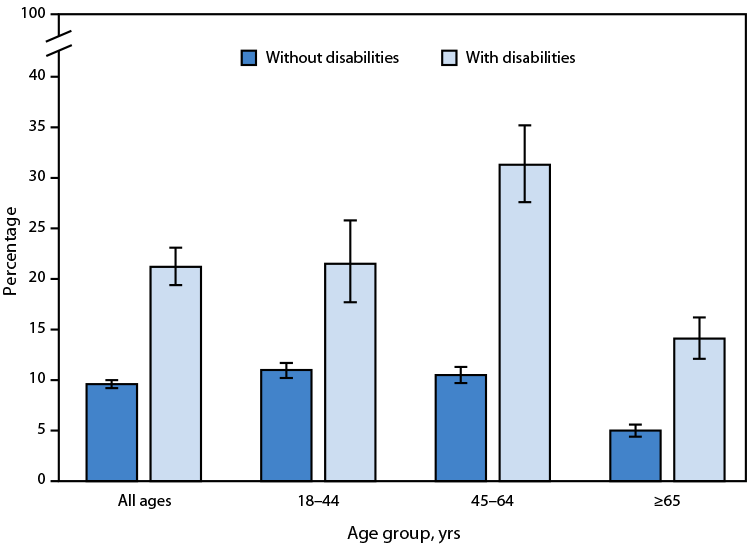
In 2023, the percentage of adults aged ≥18 years who were in families having problems paying medical bills in the past 12 months was higher among those with disabilities (21.2%) compared with those without disabilities (9.6%). This pattern was observed across all age groups. Supplementary Table: https://stacks.cdc.gov/view/cdc/164154 Source: National Center for Health Statistics, National Health Interview Read More >
Posted on byQuickStats: Prevalence of Obesity and Severe Obesity Among Persons Aged 2–19 Years — United States, 1999–2000 Through 2021–2023
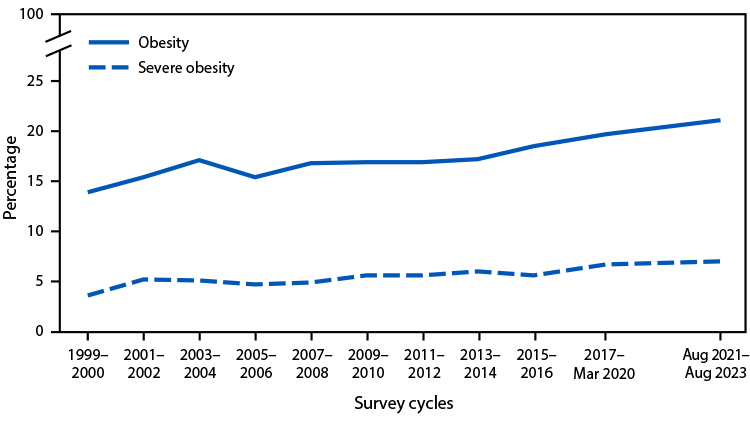
From 1999–2000 through August 2021–August 2023, the prevalence of obesity among persons in the United States aged 2–19 years increased from 13.9% to 21.1%, and the prevalence of severe obesity increased from 3.6% to 7.0%. Supplementary Table: https://stacks.cdc.gov/view/cdc/164014 Source: National Center for Health Statistics, National Health and Nutrition Examination Survey, 1999–2000 through August 2021–August 2023. https://www.cdc.gov/nchs/nhanes/index.htm https://www.cdc.gov/mmwr/volumes/73/wr/mm7341a5.htm Read More >
Posted on byNHANES August 2021–August 2023 Data Released with Obesity Report
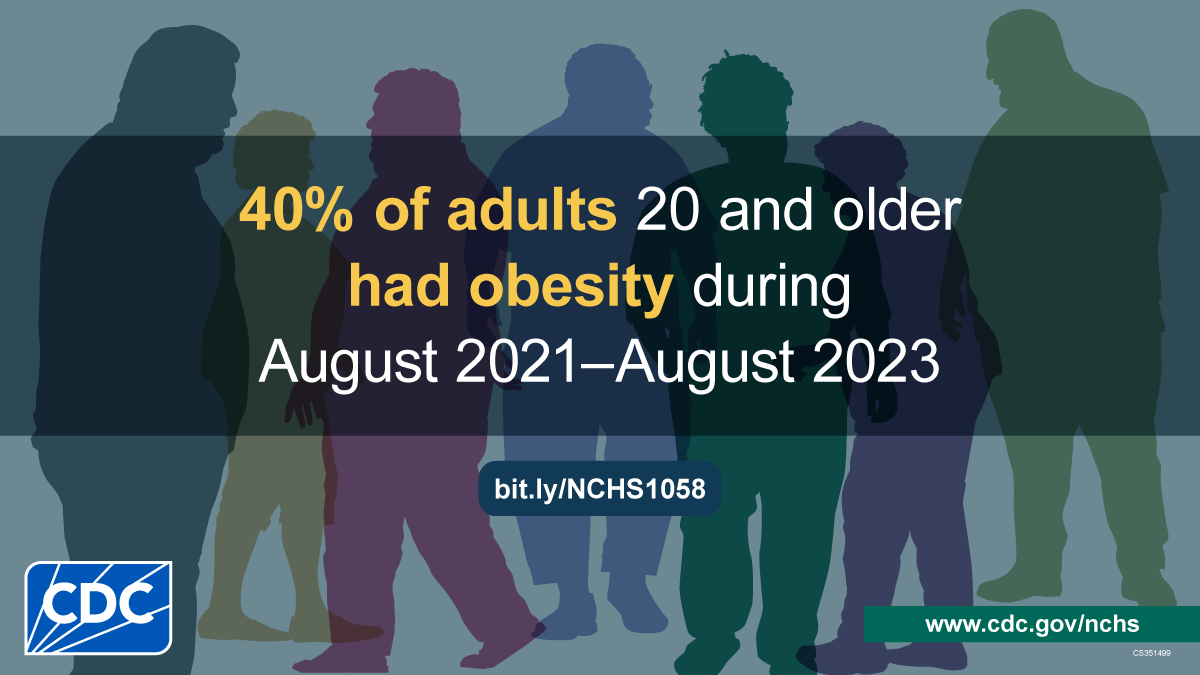
CDC’s National Center for Health Statistics recently released its first wave of data files from the August 2021-August 2023 cycle of the National Health And Nutrition Examination Survey (NHANES). NCHS also published the first report analyzing these data. The report, Obesity and Severe Obesity Prevalence in Adults: United States, August 2021–August 2023, describes recent trends Read More >
Posted on byQuickStats: Rates of Emergency Department Visits for Children and Adolescents with Acute Upper Respiratory Infection, by Age Group — United States, 2021–2022
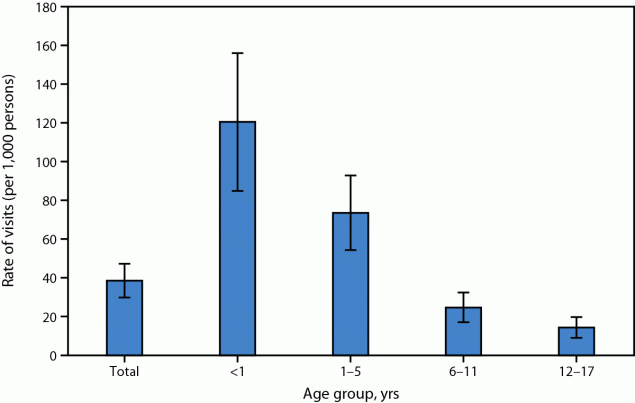
In 2021–2022, the rate for emergency department (ED) visits for children and adolescents with acute upper respiratory infection was 38.6 per 1,000 persons aged <18 years. The ED visit rate was highest for infants aged <1 year (120.5) and decreased by age, with the lowest rate among adolescents aged 12–17 years (14.4). Supplementary Table: https://stacks.cdc.gov/view/cdc/162215 Source: Read More >
Posted on byQuickStats: Percentage of Suicides and Homicides Involving a Firearm Among Persons Aged ≥10 Years, by Age Group — United States, 2022
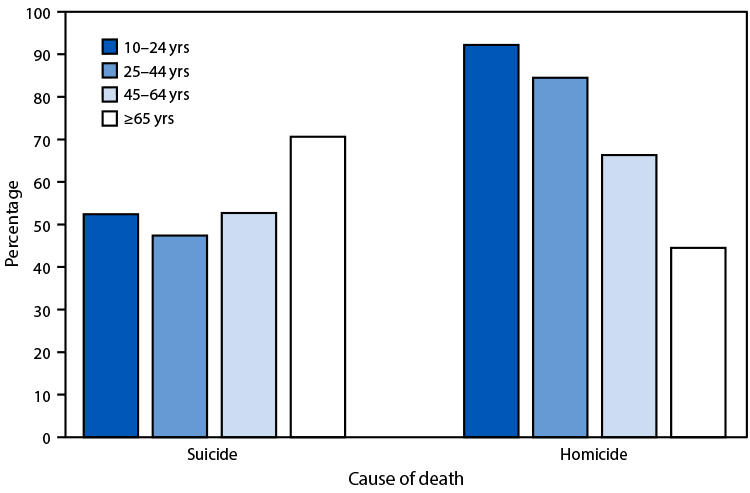
In 2022, among persons aged ≥10 years, the percentage of suicide deaths involving a firearm was lowest among persons aged 25–44 years (47.4%) and highest among persons aged ≥65 years (70.6%). The percentage of homicide deaths that involved a firearm was highest among persons aged 10–24 years and then decreased with age, from 92.2% among Read More >
Posted on byeMKF: A New Tool for Studying Small Populations
Statisticians at the National Center for Health Statistics recently developed a tool to help with the challenge of producing estimates of health conditions and other indicators of health for groups of people that may be less represented in the population. The challenge of studying small populations For researchers who study small populations , measuring health Read More >
Posted on byDiscover the Latest Additions to NCHS’ Data Query System
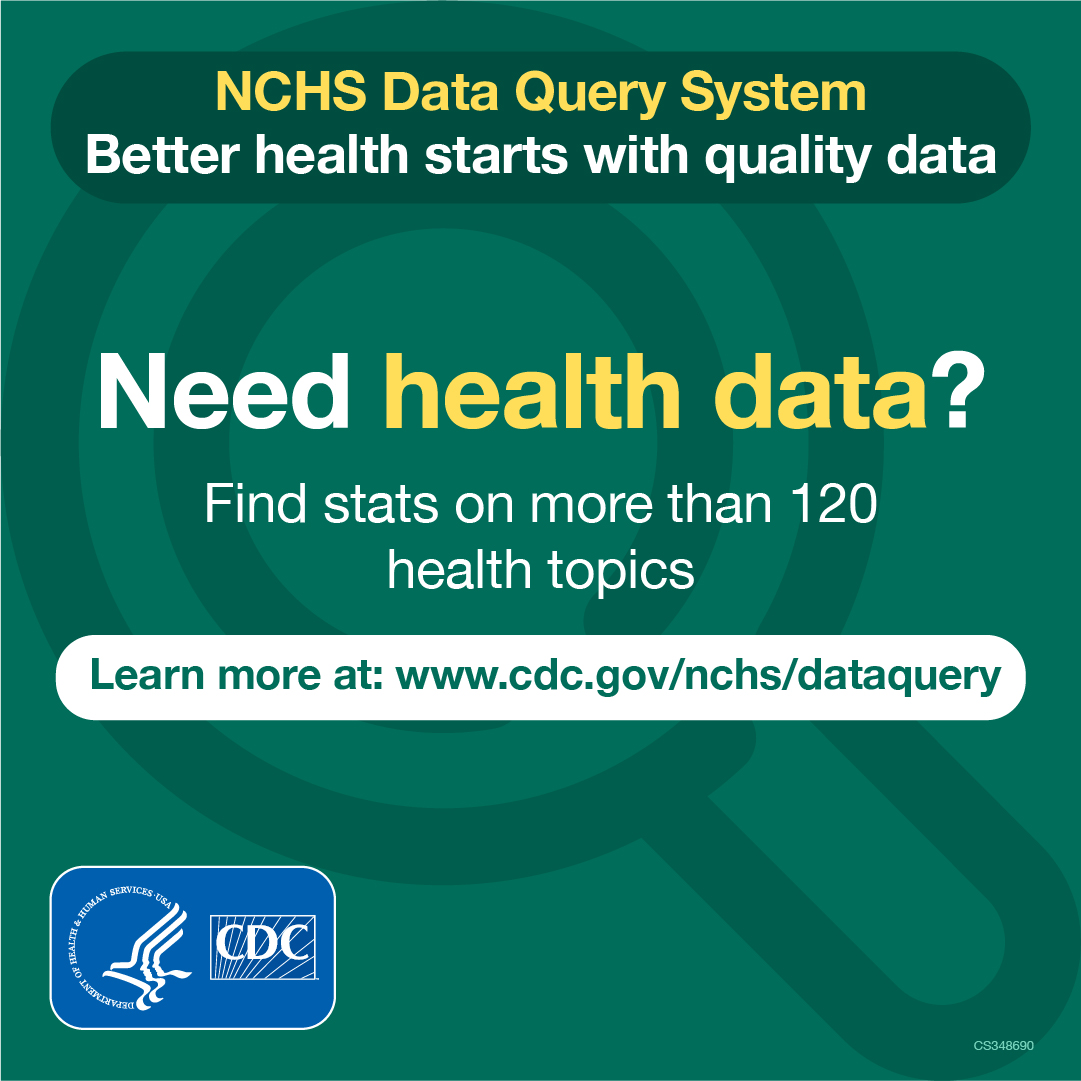
CDC’s National Center for Health Statistics has added more data to our Data Query System (DQS). This tool makes health data easier to find and use. Explore data about more than 120 health topics from multiple national data sources in DQS. Use the system to find national estimates, visualize public health trends, and download formatted Read More >
Posted on byNew Information Available from Health, United States
The National Center for Health Statistics (NCHS) recently released new topic summaries on hypertension, prescription drug use, and availability of dentists as part of Health, United States. Additionally, new information was added to data tables on a variety of health topics already available on the Health, United States website. Health, United States integrates data from Read More >
Posted on by
